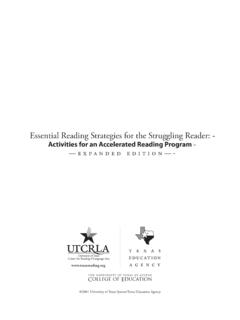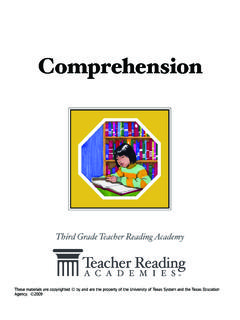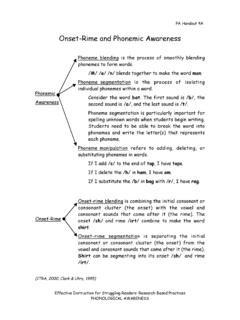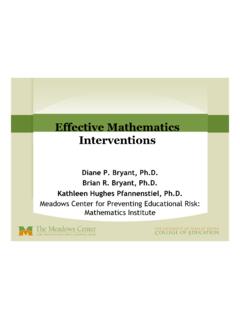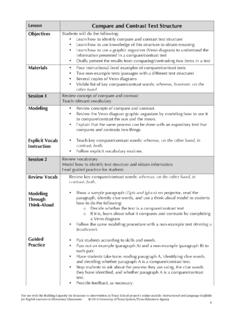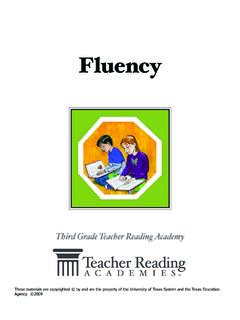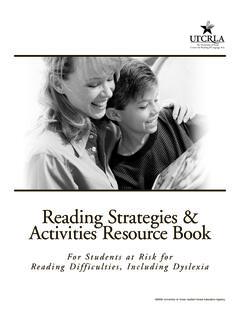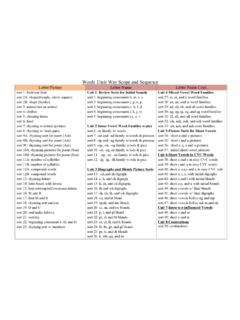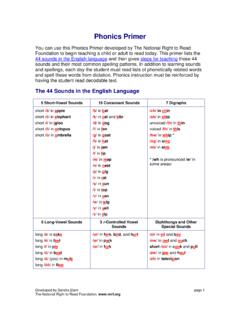Transcription of Phonics and Spelling - Building RTI
1 Phonics and Spelling Second Grade Teacher Reading Academy These materials are copyrighted by and are the property of the University of Texas System and the Texas Education Agency. 2009 Pattern e Knowledge of Spelling or Struc 2009 University of Texas/Texas Education Agency2 TRA: Phonics and SpellingHandout 1 (1 of 1) Learning to Read and Spell The alphabetic principl tural units or groups matches letters, singly or syllable patterns and their of letters, such as prefixes, in combinations, to common pronunciations suffixes, and Greek or sounds in a left-to-right can help students read Latin roots or base words sequence to read and spell and spell words.
2 Focus on meaning and the words. morphological characteristics that represent consistent spellings and/or pronunciations (words with similar meanings are often spelled the same and/or pronounced the same). Examples: Examples: Examples: blending together the /ade/ in made, fade, define and definition sounds /s/ /a/ /t/ to read shade, trade or write the word, sat Alphabet Meaning Adapted from Bear, D. R., Invernizzi, M., Templeton, S., & Johnston, F. (2000). Words their way: Word study forphonics, vocabulary and Spelling instruction. (2nd ed.). Upper Saddle River, NJ: Merrill. 2009 University of Texas/Texas Education Agency2 TRA: Phonics and SpellingHandout 2 (1 of 1) Reading Processes in Spanish Los Procesos de Lectura en Espa ol The four reading processes can be applied to both English and Spanish.
3 Decoding - Decodificaci n In Spanish, it is essential for students to be able to segment, delete, and manipulate individual phonemes. Students learn to blend sounds at the phoneme level to read syllables and words. Example: /s/ /o/ /l/ = sol Sight - Reconocimiento autom tico de palabras Although the Spanish language has a regular phonetic system, there are certain syllables or Spelling patterns that have to be learned so they can be recognized and read automatically. Example: que and qui have to be recognized as making the sound /ke/ and /ki/ without pronouncing the u. Analogy - Analog as As in English, reading by analogy refers to recalling words that have been already learned and using parts of their spellings to read new words that have similar Spelling patterns.
4 For example, when children know the word part -al, then they can read these words: cal, sal, tal, mal. An additional dimension to reading by analogy in Spanish is recognizing syllables that have been learned before and using those to read new words. If children know the syllable ma-, they can read: mam , mata, matador, mano, masa, malo, etc. Prediction - Predicci n Context also plays a very important role in learning to read in Spanish. It might seem that learning to read in Spanish is easier as it is more phonetically regular. However, Spanish readers also have to pay attention to context and syntax cues to read effectively. Adapted from Borzone, A. M., & Signorini, A. (1994). Phonological awareness, Spelling and reading abilities in Spanish-speaking children.
5 British Journal of Educational Psychology, 64, 429 439; Moustafa, M., & Maldonado-Col n, E. (1999). Whole-to-parts Phonics instruction: Building on what children know to help them know more. The Reading Teacher, 52(5), 448 458. 2009 University of Texas/Texas Education Agency2 TRA.
6 Phonics and SpellingHandout 3 (1 of 2) Guidelines for Teaching Letter Combinations After students have learned a number of common single letter-sound correspondences, they learn that some letters are often combined to represent a particular sound or sounds. Letter combinations are groups of consecutive letters that represent a particular sound or sounds in words. There is not an established order of introduction for letter combinations, but the most common combinations are usually taught first. For example, the letter combination ph appears in a large number of words, but many of these words do not frequently appear in primary texts. On the other hand, th appears in many words found in primary texts. A consonant blend refers to the combined sounds of two or three consonants.
7 For example, the /bl/ in the word blue, the /spl/ in splat, the /ft/ in left, and the /nt/ in ant are examples of consonant blends. In consonant blends, each letter retains its common sound. Students learn how to blend the sounds together, rather than learning one new sound. Begin with initial blends before moving to final blends and medial blends. For many students, blending two consonants together is easy. Some students may require more intensive instruction and more opportunities to blend consonants. In Spanish, consonant blends are called grupos conson nticos. The fl in flecha (arrow), the /bl/ in blusa (blouse), the /tr/ in trompeta (trumpet) and the /gr/ in grillo (grasshopper) are some examples of grupos conson nticos.
8 A consonant digraph is a combination of consonants that represents one unique sound, unlike the sound made by any of the individual letters of the digraph, such as the /sh/ in the word shop. When you sound out consonant blends and digraphs, just as with single consonants, be careful to avoid adding the extra sound /uh/, such as saying /shuh/ instead of /sh/. Examples of consonant digraphs in Spanish are ch, ll, and rr. vowel combinations (or vowel pairs) are two adjacent vowels in the same syllable that represent a single speech sound. For example: the ea in meat, the oy in boy, or the ow in how. As with consonants, the sound made by a vowel combination may vary. For example: the vowel pair ou in soup, could, and shout. The generalization that the first vowel is usually long and the second vowel is silent is only reliable approximately half of the time.
9 Adapted from Chall, J. S., & Popp, H. M. (1996). Teaching and assessing Phonics : Why, what, when, how. Cambridge, MA: Educators Publishing; Chard, D. J., & Osborn, J. (1999). Word recognition instruction: Paving the road to successful reading. Intervention in School and Clinic, 34(5), 271 277; Gunning, T. G. (2002). Assessing and correcting reading and writing difficulties (2nd ed.). Boston, MA: Allyn & Bacon. 2009 University of Texas/Texas Education Agency2 TRA: Phonics and SpellingHandout 3 (2 of 2) Examples of Letter Combinations Consonant Blends Consonant Digraphs vowel Pairs blue ship sail clam cash August flower chair saw glass whistle play play thimble feet slap mother ceiling gold phone Europe wolf graph few milk chef monkey belt laugh chief broom much toe cry with boil drum toy tree eat gray head scare food desk book smile out star soup wasp cow swing snow jump act string Adapted from Carreker, S.
10 (1999). Teaching reading: Accurate decoding and fluency. In J. R. Birsh (Ed.), Multisensory teaching of basic language skills (pp. 141 182). Baltimore, MD: Brookes; Chall, J. S., & Popp, H. M. (1996). Teaching and assessing Phonics : Why, what, when, how. Cambridge, MA: Educators Publishing. 2009 University of Texas/Texas Education Agency2 TRA: Phonics and SpellingHandout 4 (1 of 1) Ejemplos de Combinaciones de Letras en Espa ol Consonant Blends (Grupos conson nticos) In Spanish, the l or the r are added to certain consonants to create these grupos conson nticos.
